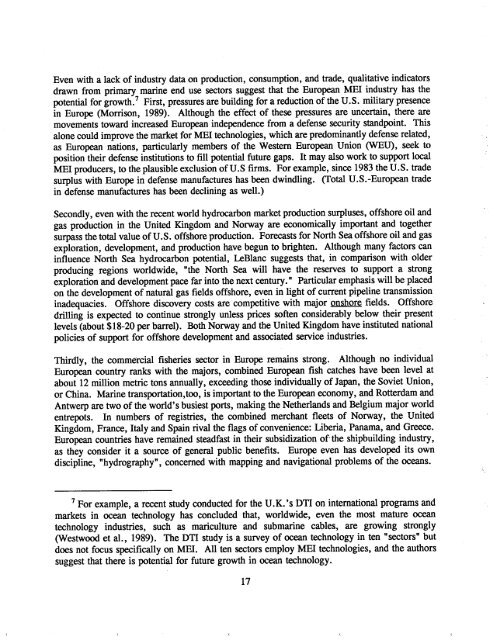WHOI-90-52
WHOI-90-52
WHOI-90-52
Create successful ePaper yourself
Turn your PDF publications into a flip-book with our unique Google optimized e-Paper software.
Even with a lack of industr data on production, consumption, and trde, qualitative indicators<br />
drawn from primar marne end use setors suggest that the Europe MEI industry has the<br />
potential for growth.7 First, pressures are building for a reduction of the U.S. milta presence<br />
in Europe (Morrson, 1989). Although the effect of these pressures are uncertn, there are<br />
movements toward increase Europe independence from a defense seurity stadpoint. This<br />
alone could improve the market for MEI tehnologies, which are predominantly defense related,<br />
as Europe nations, parcularly members of the Western Europe Union (WU), sek to<br />
position their defense institutions to fill potential future gaps. It may also work to support loc<br />
MEI producers, to the plausible exclusion ofU.S firms. For example, since 1983 the U.S. trade<br />
surplus with Europe in defense manufactures has been dwindling. (Tota U.S.-Europe trade<br />
in defense manufactures has been declining as well.)<br />
Secondly, even with the recnt world hydrocbon market production surpluses, offshore oil and<br />
gas production in the Unite Kingdom and Norway are ecnomicaly importt and together<br />
surpass the tota value of U.S. offshore production. Forecsts for Nort Sea offshore oil and gas<br />
exploration, development, and production have begun to brighten. Although many factors ca<br />
influence Nort Sea hydrocbon potential, LeBlanc suggests that, in comparson with older<br />
producing regions worldwide, "the North Sea wil have the reserves to support a strong<br />
exploration and development pace far into the next century." Parcular emphasis wil be placed<br />
on the development of natural gas fields offshore, even in light of current pipeline transmission<br />
inadequacies. Offshore discovery costs are competitive with major onshore fields. Offshore<br />
drillng is expeted to continue strongly unless prices soften considerably below their present<br />
levels (about $18-20 per barel). Both Norway and the United Kingdom have institute national<br />
policies of support for offshore development and associated service industres.<br />
Thirdly, the commercial fisheries setor in Europe remains strong. Although no individual<br />
Europe countr ranks with the majors, combined Europe fish catches have been level at<br />
about 12 milion metric tons annually, exceing those individually of Japan, the Soviet Union,<br />
or China. Marne transporttion,too, is importt to the Europe economy, and Rotterdam and<br />
Antwerp are two of the world's busiest ports, makng the Netherlands and Belgium major world<br />
entrepots. In numbers of registres, the combined merchant fleets of Norway, the United<br />
Kingdom, France, Itay and Spain rival the flags of convenience: Liberia, Panama, and Gree.<br />
Europe countres have remained steadfast in their subsidization of the shipbuilding industr,<br />
as they consider it a source of genera public benefits. Europe even has develope its own<br />
discipline, "hydrography", concerned with mapping and navigational problems of the oceas.<br />
7 For example, a recnt study conducted for the U. K. ' s DTI on international programs and<br />
markets in oc technology has concluded that, worldwide, even the most mature oc<br />
tehnology industries, such as marculture and submarne cables, are growing strongly<br />
(Westwoo et al., 1989). The DTI study is a survey of oc technology in ten "setors" but<br />
does not focus speificaly on MEI. All ten setors employ MEI technologies, and the authors<br />
suggest that there is potential for future growth in oc tehnology.<br />
17
















